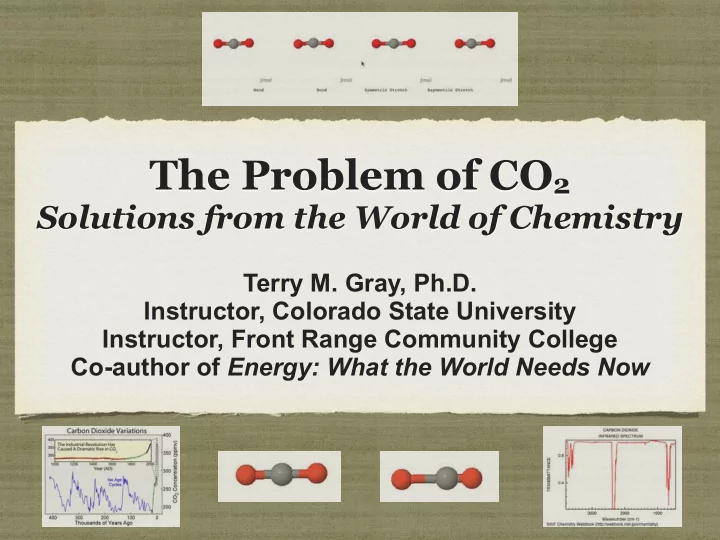

The Problem of CO 2 Solutions from the World of Chemistry � � Terry M. Gray, Ph.D. Instructor, Colorado State University Instructor, Front Range Community College Co-author of Energy: What the World Needs Now
STARTING POINTS One of the tasks of humanity is to steward God’s creation (Genesis 2:18). The earth is the Lord’s—not ours to do as we please. Yet we are called to use that which we have been entrusted in the service of others and the whole creation. Global warming/climate change is influenced by human activities, namely fossil fuel combustion.
STARTING POINTS The world's demand for energy will double by 2050 primarily due to low energy consumers in the majority world increasing their energy use Population increase in inevitable, but development/ education (of women) is the best way to slow down growth rates. Some think we will peak at 10 billion and then begin to see populations begin to shrink.
OBVIOUS TO-DO’S Reduce the amount of CO 2 emitted while maintaining/increasing the energy output Develop renewables/alternatives (including nuclear) See Pandora’s Promise (http://pandoraspromise.com) Implement conservation/efficiency Doubling the gas mileage uses half as much fuel and emits half as much CO 2 Use natural gas as instead of coal for electricity generation — Half as much CO 2 emitted per energy generated — Combined cycle technologies are 60% rather than 30-40% efficient — Assumes that leakage is minimized in natural gas production and transport — Fuel cell applications (Bloom Energy)
CARBON CAPTURE AND SEQUESTRATION (CCS) 15% of flue gas is CO 2 vs. 0.04% in the atmosphere Flue gas is CO 2 , H 2 O, N 2 , O 2 (NO x , SO x , particulates are removed) In CCS CO 2 is removed (much the way NO x 's and SO x ’s are currently removed). CO 2 is removed by a reaction with an organic base (an amine) or an inorganic base. Heating the CO 2 containing materials results in the CO 2 being liberated as pure CO 2 gas. https://www.youtube.com/watch?v=Xv6NzfouwSE https://www.youtube.com/watch?v=lH3hgqLM94U (0:45-2:25) T he pure CO2 is compressed/"liquified" and stored or sequestered in underground storage caverns (e.g. former oil fields). Enhanced oil recovery (EOR)
DIRECT ATMOSPHERIC CAPTURE Carbon Engineering (http://www.carbonengineering.com) Uses the same idea as CCS but the CO 2 is pulled out the air (where it is only 0.04%)
LIQUID FUELS HAVE TO BE PART OF THE MIX Energy density make them the best for long distance transportation and air transportation and even storage Gasoline: 46 MJ/kg (36 MJ/L) Lithium ion battery: 0.36–0.875 MJ/kg (0.9–2.63 MJ/L) Hydrogen: 142 MJ/kg (5.6 MJ/L @ 700 atm) Infrastructure Refineries, pipelines, gas stations, engines Notice that I did not say “fossil fuels”. Think of “fossil fuels” derived from CO 2
INSPIRATION FROM PHOTOSYNTHESIS You never throw throw stuff away. Always ask where “away” is. Better yet, do something with it… use renewable energy to convert CO 2 back into a fuel or useful carbon containing products. An inorganic version of the photosynthesis/respiration cycle Energy issues: 32 ATP’s out of respiration 48 ATP’s to do photosynthesis
SYNGAS SOLUTIONS Syngas: CO(g) + H 2 O(g) —> CO(g) + H 2 (g) Fischer-Tropsch: n CO(g) + 2n+1 H 2 (g) —> C n H 2n+2 (g,l) + H 2 O(g) Methanol Production: CO 2 (g) + 3 H 2 (g) —> CH 3 OH(l) + H 2 O(l) Mobil Process (with zeolyte catalysts): 2 CH 3 OH → CH 3 OCH 3 + H 2 O A clean source of hydrogen is needed (nuclear/renewable powered water electrolysis) H 2 O(l) —> 2 H 2 (g) + 2 O 2 (g)
CO 2 REDUCTION SOLUTIONS Andrew Bocarsly & Liquid Light Electrocatalytic reduction of CO 2 http://llchemical.com/ U.S. Navy Has Found A Way To Turn Seawater Into Fuel http://www.huffingtonpost.com/2014/04/09/seawater-to-fuel-navy-vessels-_n_5113822.html Extract CO 2 from seawater Make H 2 from water using on board nuclear reactor Reduction of CO2 to produce fuel
THE COST OF CARBON CCS is estimated to cost 40% more By the comparison to photosynthesis the cost is 150% more
ENERGY: WHAT THE WORLD NEEDS NOW Terry M. Gray & Anthony K. Rappé http://energywhattheworldneedsnow.com
Recommend
More recommend